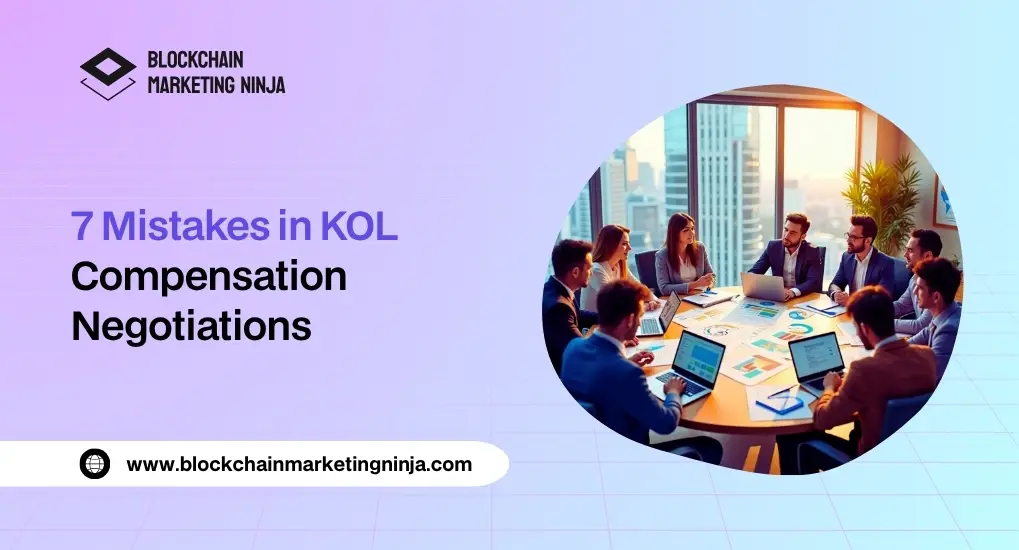Key Opinion Leaders (KOLs) are important when it comes to generating trust and awareness in Web3. They inspire acceptance, increase trust, and influence community discourse. However, influencer deals are not managed wisely on many promising projects. Terms of poor payments usually result in budget loss, legal action, or a backlash by the community. The majority of these problems stem from KOL negotiation mistakes. This guide identifies the seven most prevalent and expensive mistakes made by Web3 teams. Get to know how to prevent them and establish long-term, open cooperation.
7 Mistakes To Avoid When Negotiating KOL Compensation
Mistake 1: Ignoring Vesting and Lock-up Schedules
Providing tokens without a vesting plan is a major mistake during a KOL negotiation. Projects might run into troubles if they pay KOLs in one go. The influencer can sell the tokens immediately, which would drive the token price down. This could damage investor confidence and create an adverse feeling.
The Solution:
Employ vesting and lock-up plans. Connect token rewards with milestones or delivery schedules. For example:
- Increase up to 25 percent of tokens in the first month of the campaign.
- Outstanding tokens are emitted in excess of three months.
- This strategy keeps the KOL invested in your growth in the long term, as well as safeguarding your token value.
Mistake 2: Over-relying on Highly Volatile Native Tokens
Making full payments using native tokens is risky. The prices of tokens are subject to change overnight. And when the price plummets, the KOL has no interest in continuing the promotion. In the worst scenarios, they can give up on the project entirely. This is a common oversight, often corrected when hiring a Web3 KOL marketing agency to manage influencer relationships.
The fix:
Create a hybrid model. Provide half payment in stablecoins or fiat and half in the tokens of your project. This balance minimizes the financial risk on both sides. It makes the influencer remain motivated despite the changing market conditions.
Mistake 3: Failing to Define a Clear Scope of Work (SOW)
A significant number of KOL negotiation mistakes occur because of ambiguous expectations. It is not enough just to say that we should promote our project. The absence of a scope might lead to low-effort content posted by KOLs, which has no actual value.
To prevent this, write an SOW which covers the following details:
- The quantity of posts or videos is necessary.
- Particular platforms (Twitter, YouTube, or TikTok).
- Type of content (thread, AMA, review, etc.).
- Minimum engagement targets.
- Mandatory disclosure labels (e.g. #ad or #sponsored).
This makes it more accountable, and lets you gauge performance.
Mistake 4: Not Utilizing Performance-Based Incentives
Instead of using fiat payments as incentives, use bonuses based on real performance. Apply KPIs such as wallet sign-ups, whitepaper downloads, or community growth. Provide additional incentives in case of the accomplishment of specific objectives. Such an approach encourages influencers to provide actual influence. It also enables projects to compensate for quantifiable achievements over ambiguous involvement. Performance-based compensation guarantees the reasonable worth to both parties and matches promotion with significant accomplishments.
Also read: KOL Marketing for DeFi Projects: Strategies to Build Trust and Growth
Mistake 5: Lack of Legal and Regulatory Clarity
Web3 is international, and there are laws and regulations in every place. Countries have their own regulations about Web3, and is something that many projects tend to overlook. Failure to pay taxes or disclose may result in a fine or legal consequences.
Smart solution:
Never leave legal terms out in contracts. Mention:
- On fiat or token payments, who pays taxes?
- Mandatory regional disclosures (ex, SEC or FTC).
- IP of deliverables and content.
This cuts down risk and creates trust. Each strategic KOL engagement needs to have a compliant contract that protects both sides.
Mistake 6: Compensating Based on Follower Count Alone
It is a grave error to pay influencers based on the basis of their followers because most of them can be dormant or counterfeit. Big numbers do not necessarily mean actual involvement.
To fix this:
Assess quality rather than quantity. Focus on:
- Like rate (likes, comments, shares).
- Demographics of the audience (crypto-native or not?).
- Past campaign conversion history.
Select KOLs that actually impact your target market, not anybody with a big following. This is one of the KOL negotiation mistakes that you must avoid if you’re looking to save money and credibility.
Mistake 7: Offering Flat Rate Without Considering Market Rate or Tier
Web3 influencers are categorized into levels: Nano, Micro, Macro, and Mega. Flat rate payment causes either overpaying or underpaying. Findings: young rates of each level before negotiating KOL deals.
For example:
- Nano (1K to 10K followers): community-centric.
- Micro (10K–100K): niche specialists
- Macro (100K–500K): mainstream reach
- Mega (500K+): celebrity-like visibility.
Being aware of these levels can help you judge the reach of a KOL and make payments accordingly, while remaining professional and respectful.
Conclusion: Negotiate for Longevity and Trust
Influencer collaboration is all about relationships, not about transactions. The best projects are those in which compensation is being done in the form of a partnership plan and not a single payment. Loyalty, equitable, and sustainable brand development emerges by avoiding these KOL negotiation mistakes.
Smart Web3 KOL compensation plans reward performance, consider the legal regulations, and are centered on engagement quality. If you have a Web3 start-up, review your KOL contracts. Ensure that they are made to be compliant, transparent, and successful in this dynamic ecosystem.
